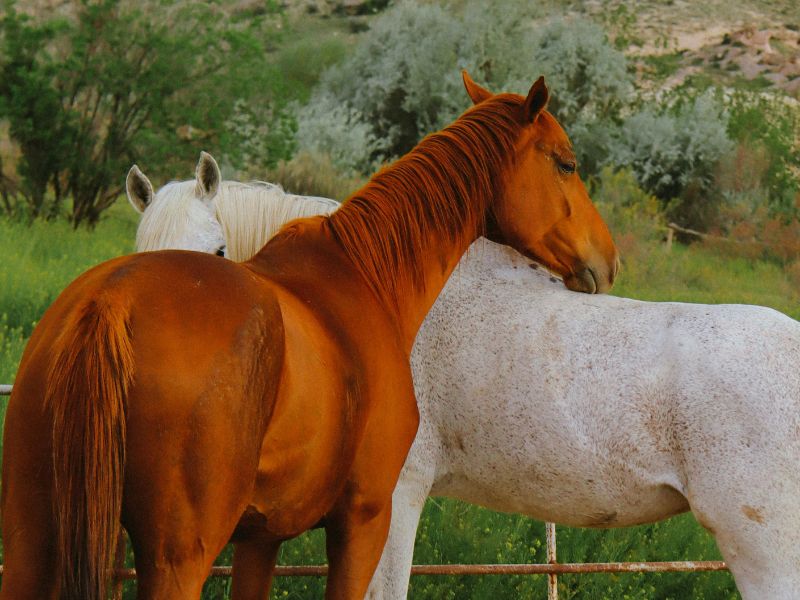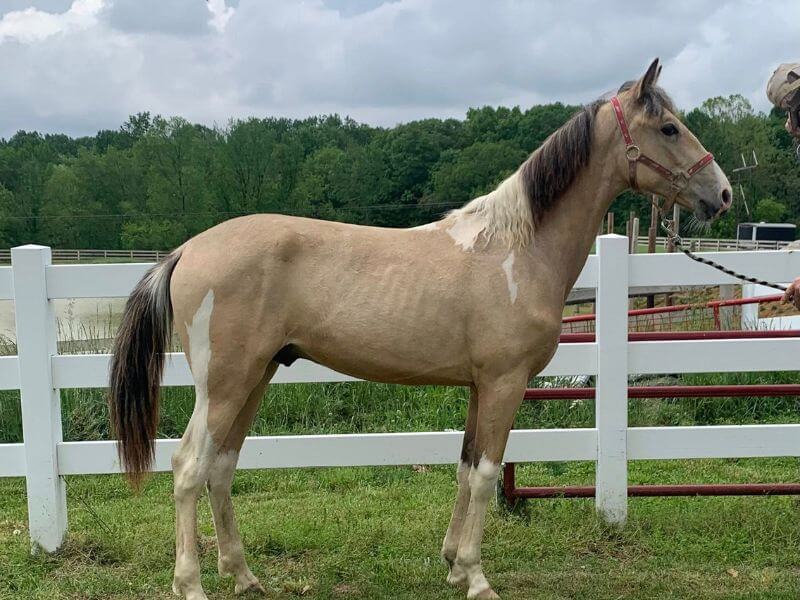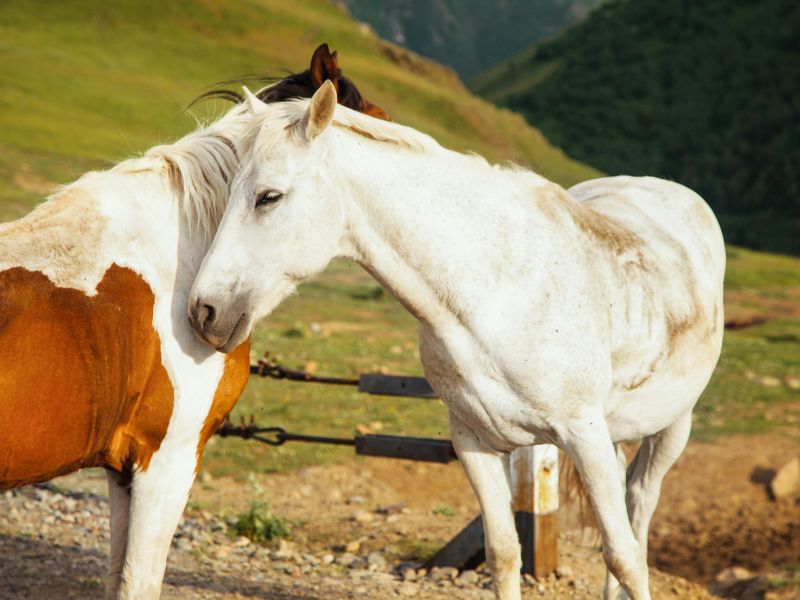In the equine world, gelding is a term used for a male horse that has been neutered through a castration procedure. Throughout history and tradition, it has been a common practice used to control the hormones and sexual behavior of stallion-like, aggressive horses.
Before gelding, it’s important for a horseman to consult with a trusted vet. This procedure is mostly done on young colts with aggressive temperaments to make them more focused, calm, and responsive.
Gelding is actually a vet care procedure used to make an adult animal non-breeding. A gelding horse can still work, ride, and bring joy in the arena.
So whether you have a stallion, foal, or any other animal, this simple and detailed article will help you understand everything about gelding. After reading this guide, you’ll know exactly what a gelding horse is.
What Is a Gelding Horse?
The surgical removal of the testicles of a male horse is called gelding. Horses are castrated or neutered for both veterinary and behavioral reasons. Gelded horses are highly reliable for recreational riding and competing because they are calmer, gentle, and steadier in nature.
Before gelding, the male horse capable of breeding is known as a stallion. After gelding, the horse is no longer able to breed, which makes it barren.
So, gelding is used to reduce the distractions caused by hormones. It improves the behavior and temperament of your companion. It also makes your horse more sociable and easier to handle, which is ideal for riding.
In the Old Norse language, the word geld is derived from gelda, which means barren or castrated. By understanding the history and definition of this practice, you can make the best decision for your stallion.
Why Some Horses Are Gelded?
Male horses can often become aggressive, feisty, and stubborn, especially when in heat or near mares. That’s why it’s important to reduce testosterone to control the raw male power of stallions.
Without gelding, they can be dangerous to humans and other horses in the barn. So, this veterinary procedure of gelding helps with safety, control, and behavioral management.
In gelding, young horses are castrated or neutered by surgically removing their testicles. It not only removes their reproductive function but also reduces conflict and increases riding safety. It makes horses calmer, more tractable, and much easier to handle.

It also makes stallions better-behaved in domestic horse herds and in bachelor herds where herd dynamics can shift quickly. So, gelding is ideal for inexperienced or beginner-friendly horse lovers who want to train and ride their horses.
Young exhibitors are not permitted to show stallions in horse shows because they require experienced handlers. Due to their instinct and muscle power, stallion behavior is considered risky.
To control the gene pool, about 0.5% to 10% of stallions are kept as breeding stock. This prevents lower-quality or unsuitable stallions from passing on unwanted traits. A dominant stallion can guard 10 to 12 mares, but with gelding, you can maintain reproductive control.
The Methods to Geld a Horse
Gelding a male horse by removing its testicles makes it more focused and calmer. Before gelding a young colt, it’s important to have a conversation with your trusted vet. He will explain the simple procedure, which takes less than 15 minutes to stabilize your horse. In this method, the horse is sedated using either local or general anesthesia.
There are two main ways to perform castration. The first is standing castration. In this process, local anesthesia is administered to numb the area for surgery while the horse stays on its feet. The second is recumbent castration, in which the horse is fully asleep and lying down under general anesthesia.
Most of the time, the veterinarian goes through each step during a medical demonstration. In the surgery, they make a small incision in the scrotum, and then the testes, epididymis, and part of the spermatic cord are removed. Using emasculators, they crush the cord to prevent bleeding. When required, they also tie ligatures.
There are also some risks involved in this process. If a horse is cryptorchid, then testicle removal becomes trickier because one of the testes has not descended. So, the horse can still act like a stallion despite being partially gelded.

There’s a risk of getting hurt during standing castration due to an unexpected reaction. That’s why, in modern veterinary practices, horses are properly checked and restrained before the operation. Sedatives like detomidine and even butorphanol are used to reduce movement and stress.
In gelding a horse, there may be complications like infection or injury, but the benefits of this process are worth more than the risk. Gelding a horse makes it calm, friendly, and easier to train. Horses have been gelded for centuries. The written work by Aristotle, dating back to 350 B.C.E., proves the long history of this practice.
Pros and Cons of Gelding Horse
Gelding a horse has its own pros and cons. Compared to a stallion, a gelded horse has a more stable and easy-going personality, but it also comes with some challenges.
Advantages of a Gelding Horse
- A gelding horse has a calm and well-balanced temperament.
- They do not show dominance when they are in heat or near mares.
- They are best for trail riding, training, and horse shows.
- Ideal for kids and beginners due to their friendly personality, even temperament, and tractable nature.
Disadvantages of a Gelding Horse
- A gelding horse can’t breed, so you cannot have foals or continue a specific bloodline.
- Some gelded horses can still be stubborn, lazy, and may not be the best match for your riding goals.
- In gelding a horse, the complication rate for standing castration is around 22%, and 6% for recumbent castration.
- Without complications, the average cost for gelding is about $250. The cost of antibiotics and other medicines can add more to it.
How to Tell If a Horse Is Gelded
If you are a new horse owner and want to know if your horse is gelded or not, then by checking physical signs, noticing some behavioral clues, and getting vet confirmation, you can easily figure it out.
Physical Signs
In identifying a gelding horse, one of the easiest ways is to check underneath the horse. A gelded horse will not have testicles present in the scrotal sac. The testes and spermatic cord are surgically removed during the castration procedure.
If a horse still has visible testicles, then it is either a stallion or a cryptorchid horse, whose testicles have not descended.
Behavioral Clues
Horse behavior is also important for spotting gelding characteristics. Geldings are more calm, less territorial, and show less aggression near mares. Their balanced temperament makes them perfect for beginners, kids, or trail riders.
Vet Confirmation
If you are still not sure whether your horse is gelded or not, then visiting a veterinarian is the best way to confirm. They will perform a physical exam or use an ultrasound to check whether the horse is neutered or not. Ultrasound is especially effective for dealing with cryptorchid horses, where the signs are not clear.

Gelding vs Stallion: Key Differences
Geldings and stallions look similar, but they are different in behavior and handling. Because of the removal of testosterone, the gelded horse has a quiet, laid-back, and cooperative nature, which makes it the best and safest choice for kids and beginner riders.
On the other hand, stallions are spirited, territorial, and challenging to handle. That’s why many owners prefer a gelding horse, as they are easier to manage, more relaxed, and stay focused on the job at hand.
But if you have breeding purposes, then the stallion is the horse for you. The hormones in stallions make them assertive and aggressive when turned out near mares. Even domesticated stallions show stallion-like behavior like lunging and biting.
The physical attributes of stallions, such as muscular bodies and thicker necks, are a result of being un-castrated and heavily influenced by hormones. Stallions are ideal for experienced equestrians who have the patience to handle temperamental horses.
In older cultures, stallions were handled in wild herds. At that time, stallions were more preferred due to their hard work ability and strength. But now, in modern riding horses, gelding horses are more popular because of their calm and friendly nature.
They also don’t show concern for female horses in heat cycles. So, gelding horses are more consistent and less moody than stallions. If you don’t have any mating purpose or want to prevent unwanted offspring, then a gelding horse is the better choice. These chill dudes are the best riding horses that stay focused in both work and play.
Daily Care for a Gelding Horse
After the castration procedure, care plays a critical role in the recovery of a gelded horse. You need to give extra attentiveness for a few days to prevent edema, abscess, or infections. You should keep the area around the incision clean so that the wound can drain freely.
In the first week, the vet may also prescribe antibiotics, tetanus antitoxin, and even painkillers or analgesics. These medications are commonly administered to manage complications and reduce the risk of further development of issues.
In the recovery period, light exercise like hand-walked sessions is crucial for healing. Taking your horse on a short trail ride is also allowed. These activities support the system in flushing out leftover hormones. You also need to monitor the temperament, because it might take a few weeks for stallion-like behaviors to subside.
Routine checkups, dental care, and hoof maintenance are just as important as aftercare. In gelding care, giving a balanced diet according to the activity level of your horse is key.
Because geldings are laid-back and even-keeled, they may burn fewer calories. Feeding your companion based on their workload, body shape, and age helps keep them healthy and strong.
Cleaning the sheath is also very important. Because gelded horses can’t extend their penises as frequently as stallions, smegma—which is a mix of dirt, oil, and dead cells—can accumulate. So, regular cleaning is key to prevent irritation and help your horse stay comfortable.
Care of a gelding requires understanding, consistency, and a little love. Caring and working together with love and affection is truly the best part of horse ownership.
Famous Gelding Horses in History & Sports
Over the years, we’ve seen many famous geldings in horse racing, movies, and history books. One of the most iconic champion gelding horses is Kelso, a racing legend known for winning Horse of the Year five times in the 1960s. Another is John Henry, who ruled the track by earning over $6 million during his career.
In Hollywood, the horse Trigger, though not a gelding himself, inspired many to choose geldings for their calm, trainable nature in films. In recent times, Wise Dan, a gelding known for his speed and composure, became a two-time Horse of the Year winner. These horses highlight the laid-back temperament, focus, and consistent performance of gelding horses.
Should You Choose a Gelding?
As a first-time horse buyer, you may wonder, “Should I get a gelding?” Gelding horses are known for their easy temperament, trainability, and manageable nature.
So, if you want a beginner-friendly horse that’s calmer, more tractable, and less aggressive, then a gelding is the best choice for you. They are ideal for kids, trail riders, and new owners.
But before buying a gelded horse, there are a few things you should consider. Geldings are excellent as riding companions, but they’re not the right fit if you’re planning to breed. They’re especially suitable if you don’t have much experience with horses.
So, it all depends on your specific needs—if you’re looking for a horse for breeding, then a gelding may not be a perfect match. But if you want a reliable, friendly, and easy-to-handle horse, then a gelding is the right choice.
Unlike broodmares, which are kept for breeding purposes, geldings are valued for their calm demeanor and performance abilities. Explore more about broodmares and their importance.
Conclusion
Geldings are neutered male horses. They are considered dependable partners due to their less aggressive behavior compared to stallions. Gelding a horse helps make your horse more calm, reliable, and friendly—without affecting its health or performance.
References:
Stallion Management. Equine Reproductive Physiology, Breeding, and Stud Management.
Equine Research Datbase: Geldings and Horses
